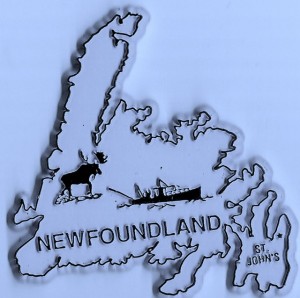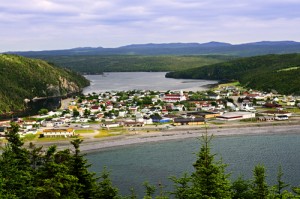by @AnnieDaylon
The province of Newfoundland and Labrador is located on the eastern part of Canada; Labrador is on the mainland of Canada and Newfoundland is an island. I was born and raised on Newfoundland’s Avalon Peninsula (south east corner) and I enjoy weaving stories through the history of that area. Here are a few facts:
-
Newfoundland officially joined Canada in 1949 as the 10th province.
-

When it’s 7 a.m. here in British Columbia, it’s 11:30 a.m. in Newfoundland.
The island of Newfoundland forms an almost perfect equilateral triangle on a map. Port aux Basques, L’Anse aux Meadows, and St. John’s are all nearly the same distance apart.
-
The island of Newfoundland has its very own time zone, one that it does not share with its counterpart, Labrador. Newfoundland time is thirty minutes ahead of Atlantic Standard Time.
-
St. John’s, the capital city of Newfoundland and Labrador, is the oldest city in North America.
-
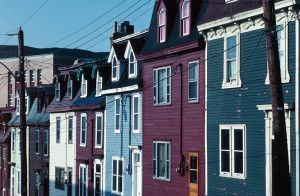 In downtown St. John’s, there are many vibrantly-colored Victorian row houses, fondly known as “Jellybean Row.” When people ask how to find Jellybean Row, they are often surprised to learn that no one street has that actual name. Jellybean Row is a nickname for all row houses in that area.
In downtown St. John’s, there are many vibrantly-colored Victorian row houses, fondly known as “Jellybean Row.” When people ask how to find Jellybean Row, they are often surprised to learn that no one street has that actual name. Jellybean Row is a nickname for all row houses in that area. -
Often, news reports from Newfoundland warn drivers to be on the lookout for moose on the highway.
 I have even heard moose referred to as Newfoundland speed bumps. 🙂 It surprised me to learn that moose are not native to Newfoundland. One pair was introduced in 1878 and thought not to have survived. Two more pairs were introduced in 1904. Currently, there are 100 000 moose there, assumed to be descendants of the 1904 pair.
I have even heard moose referred to as Newfoundland speed bumps. 🙂 It surprised me to learn that moose are not native to Newfoundland. One pair was introduced in 1878 and thought not to have survived. Two more pairs were introduced in 1904. Currently, there are 100 000 moose there, assumed to be descendants of the 1904 pair. -
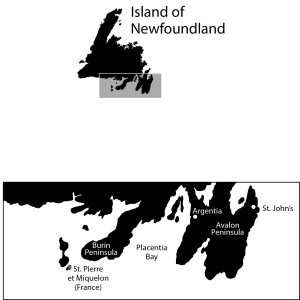
Argentia, the main setting for OF SEA AND SEED, Book I of my Kerrigan Chronicles series, is one of the two foggiest land areas in the world; the other is Point Reyes, California. Both places have over 200 foggy days a year.
-
Jerseyside, which is near Argentia, got its name from the large number of people who came from Great Britain’s Channel Islands– Jersey and Guernsey.
-
Cape Spear, about fifteen km east of St. John’s, is the most easterly point in North America. It is a major tourist attraction and is also home to a WWII bunker.
-
Screeching-in is a traditional way of welcoming first-time visitors to the province. It consists of a shot of screech (rum), a short recitation, and the kissing of a cod.
-
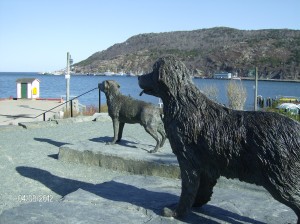
I took this photo at Harbourside Park in St. Johns, NL. There are two sets of these dog statues in St. John’s. The other is on Signal Hill. (Sculptor–Luben Boykov)
Both parts of the province have a dog breed named after them: the Newfoundland dog and the Labrador retriever. (To learn more about the dog statues in the photo on the right, CLICK HERE.)
-
Memorial University in St. John’s is the largest university in the Atlantic region (18,000 full and part-time students.)
-
The oldest continuous sporting event in North America is the St. John’s regatta held on the first Wednesday of August
-
 Due to unique dialect, Newfoundland and Labrador has its very own dictionary. (To read former post, “Newfoundland Dialect: Derivation and Appreciation,” CLICK HERE.) The Dictionary of Newfoundland and Labrador, a “unique collection of language and lore” is both informative and fun, an absolute treasure amidst my book collection. For me, it is not only a valued reference for the Newfoundland language, but also, in a rapidly changing world, a valuable record of that language.
Due to unique dialect, Newfoundland and Labrador has its very own dictionary. (To read former post, “Newfoundland Dialect: Derivation and Appreciation,” CLICK HERE.) The Dictionary of Newfoundland and Labrador, a “unique collection of language and lore” is both informative and fun, an absolute treasure amidst my book collection. For me, it is not only a valued reference for the Newfoundland language, but also, in a rapidly changing world, a valuable record of that language.
And there you have it! A few tidbits about my pine clad hills. If you have interesting or fun facts to add, please send them my way!
To sign up for my newsletter, simply fill in your name and email address in the space provided on the right side of every website page. Rest assured that your email address will be held in the highest confidence and will not be shared or distributed for any purpose.
My best to you and long may your big jib draw,



